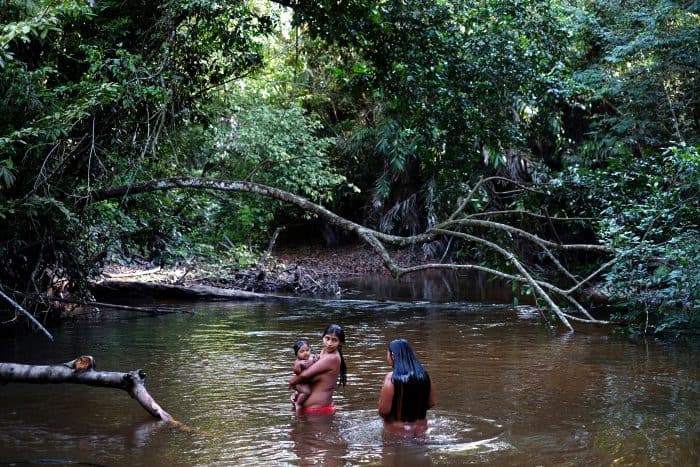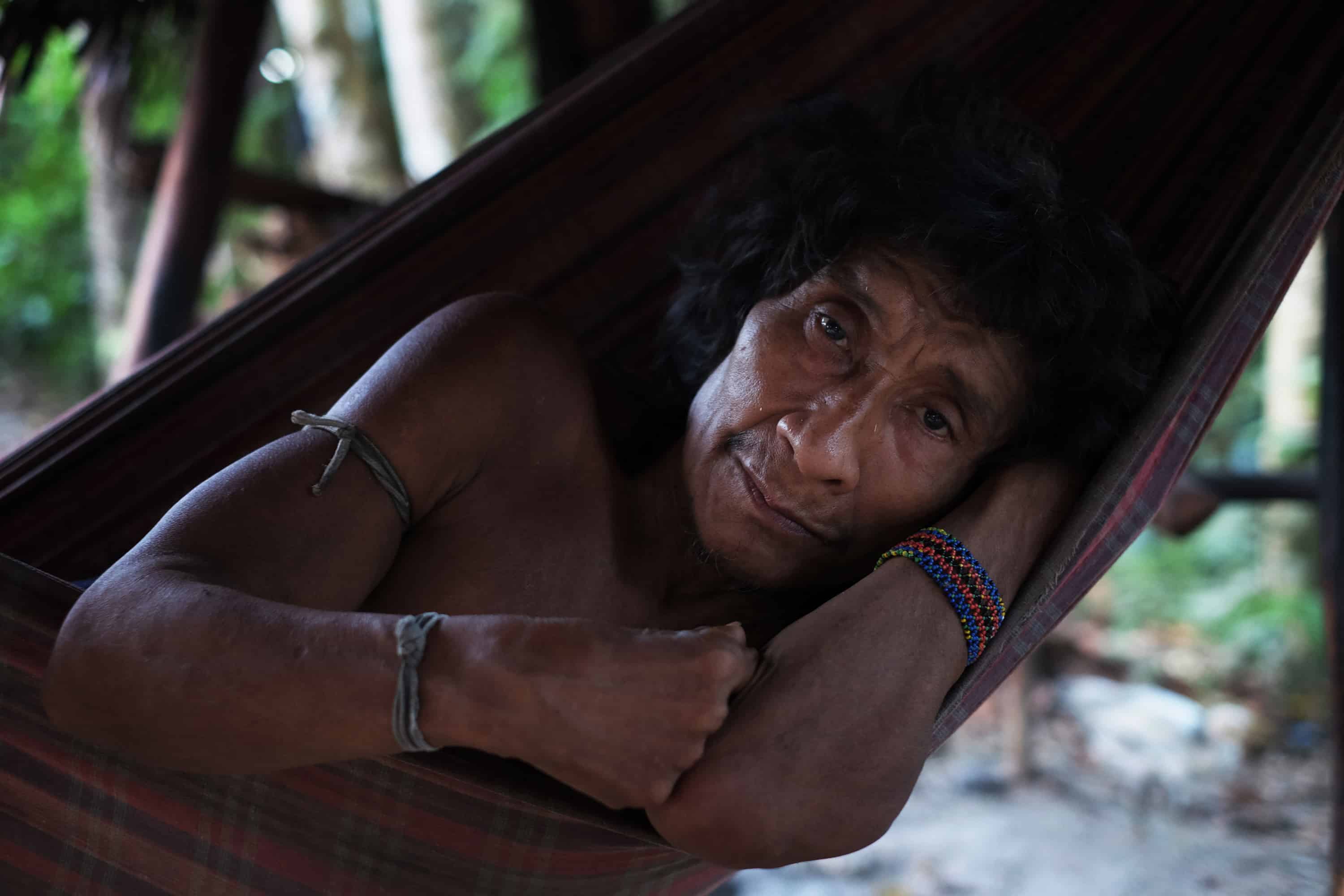AWÁ INDIGENOUS LAND, Brazil – In January 2014, the Brazilian government sent the army into this corner of the Amazon, deploying soldiers backed by bulldozers and helicopters to clear out hundreds of families living illegally on a reserve for indigenous people.
The three-month offensive was aimed at saving what has been called the world’s most endangered tribe – the Awá – from extinction. It was Brazil’s biggest-ever operation of its kind and was hailed by activists internationally.
But now, signs of the settlers’ return are rife. Cattle are back grazing on this sprawling reserve. Plots of vegetables have been found growing in isolated areas. Loggers are culling the valuable wood in the forests.
It took more than 200 Brazilian soldiers, police officers and government agents to evict 427 families of farmers and settlers last year and flatten their homes and outbuildings. But today there are just half a dozen employees from the government’s indigenous agency to protect the 450-square-mile reserve in northeastern Maranhão state.
Raimundo Oliveira, 54, is one of them. On a recent morning, he pointed a stick at the thick forest to show where loggers had built a rough road a couple of miles away from the Awá tribe’s tiny village of Juriti.
“They are squeezed,” he said of the indigenous people. “Loggers one side, settlers the other.”
The Awá tribe lives on the eastern fringe of Brazil’s Amazon rain forest. It is estimated that the population of the Awá totals just 450 people. (Dom Phillips, Bonnie Jo Mount, Jason Aldag/The Washington Post)
—
Brazil has hundreds of indigenous tribes and is believed to have more “uncontacted” people living in its forests than any other country. But the Amazon has been subjected to waves of development, starting with a 19th-century rubber boom. In recent decades, roads were built through this area, and a new railway sliced through the Awá tribe’s homeland.
Today the Awá are down to about 450 tribe members, from an estimated 600 in 1960. Most live in small villages on this reserve and an adjacent one, staying close to their hunter-gatherer traditions, unlike other tribes that survive on government welfare payments. About a hundred Awá tribe members still roam the rain forests with no contact with society.
Washington Post journalists were given rare permission by the tribe to visit the Awá reserve. In the main village, Juriti, residents share their mud-brick homes with animals they keep as pets: small raccoon-like creatures called coati, large rodents called agouti, as well as tortoises, birds and monkeys. Hunting provides the tribe’s main sustenance, though its members also do some farming.
Their land was declared a protected indigenous reserve in 1992, but in the lawless Amazon, little was done to keep outsiders from moving in. Over time, an estimated 34 percent of this reserve was deforested by loggers and settlers. As the activity edged closer to Juriti, a village of 67 Awá, the sound of trucks, tractors and chain saws scared off the prey hunted by the tribe.
“My family were hungry,” said Pyray-Ama-A Awá, 35, chief of Juriti. “There is no prey when the loggers are close.”
In 2012, Survival International, a British-based group that advocates for tribal people, launched a campaign to save the Awá, featuring British actor Colin Firth and designer Vivienne Westwood. Supporters bombarded the Brazilian Justice Ministry with 57,000 e-mails demanding action.The pressure increased as Vanity Fair featured the Awá in an article titled “The Last of Eden,” illustrated by Sebastião Salgado, the renowned Brazilian photographer.
In 2014, the Brazilian government acted. Settlers were given a 45-day warning to leave the territory. Some had to be removed by force. Now, said Pyray-Ama-A Awá, “it is beautiful. They took the people out.”
And the Awá can hunt. “The prey comes closer,” said Hamõ-Koma-Á Awá, 28.

‘Still big difficulties’
But the gains are limited. There are areas of the forest where loggers still operate. And sightings of the remote Awá are increasing.
That is a problem because the “non-contacted” tribal members have low immunity to infections such as the flu and can die after exposure to outsiders. In the 1980s, the Brazilian government reversed decades of policy and decided it would leave isolated indigenous groups alone unless they are in danger.
Two employees of the government’s agency for indigenous affairs were recently manning the gates of the Awá’s reserve. One, Claudmiro Silva, wore a pistol in the waistband of his shorts. Both men said they felt vulnerable in this dirt-poor area, where gunmen can be hired for $100 or less and local landowners and loggers have been known to resort to violence. “We hope for an improvement here, for our security,” said João Sampaio, Silva’s colleague.
There are clear signs that the settlers still are active in the reserve. All that remains of one village, Cabeca, is a goal post sagging into the long grass, the shell of a white church, and a few squashed wooden roofs.
But on a recent day, mules wandered through the village. Men passed on motorbikes. There were hoof prints a few miles up the dirt road. In nearby towns, there were reports of three farmers grazing herds of up to 600 head of cattle on the reserve. Sampaio and Silva have found plots of vegetables in more-isolated regions.
“Things improved here,” Sampaio said, “but there are still big difficulties.”
‘Everybody knows’
In the scruffy, bustling farming town of São João do Caru, a half-hour drive outside the reserve, resentment over the government’s military operation still simmers. Many of those who were evicted relocated here. Raul Ferreira, 48, lost 741 acres. He said he had bought the land in 1997, after it had been declared part of the reserve but before the final presidential decree was issued. The Brazilian government has declared such sales invalid.
“I hope nobody has to go through what I went through,” he said.
Shopkeeper David Ferreira said at least 30 people in the town are logging in the reserve, which is targeted because much of the rest of the region was deforested years ago.
“It is invaded from one side to another, with people making plots and cutting down trees,” he said. “Everybody knows.”
Under Brazilian law, landowners in the Amazon can cut down 20 percent of their forest and apply to their state government for a “management plan” to farm wood sustainably in the remaining 80 percent. These permits are poorly controlled and are often used to launder wood taken from indigenous reserves, said Luciano Evaristo, head of environmental protection for the Brazilian environment agency in the capital, Brasilia.
The environment agency has staged two operations this year to expel loggers from reserves in the state. Each time, the loggers came back. They have many incentives: Illegal logging is highly lucrative, the penalties are low, and Brazil’s cumbersome justice system is easily manipulated.
“Not even the American army could defend all the indigenous areas in Brazil, because of the size of them,” Evaristo said.
Delmiro de Freitas is the owner of a sawmill in São João do Caru that was idle on a recent afternoon. “I work legally,” de Freitas said. He emphasized that he only buys wood that is properly handled and sold.
But the environment agency’s public database lists 15 violations for de Freitas and his company from 1996 to 2013. He has paid some fines and is disputing others, including a 2009 fine in his name for $188,000 that officials said was for selling wood without a license. De Freitas said in a telephone interview that was done fraudulently using his name.
© 2015, The Washington Post

